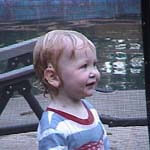
Colman Collins turned 2 on March 30, a momentous birthday for any toddler but especially so for Colman. When he was still in the womb, he was diagnosed with hypoplastic left heart syndrome, a condition in which the left side of the heart is not fully developed. With a left ventricle, aorta, aortic valve and mitral valve unfit to meet the heart’s workload, Colman required lifesaving intervention immediately after birth.
Colman is an active, energetic child today, thankfully. His case has been managed by James H. Rogers Jr., M.D., clinical professor of pediatrics at the Health Science Center and medical director of the Children’s Heart Network. Colman has benefited from two surgeries led by John H. Calhoon, M.D., the Calhoon President’s Council Chair for Excellence in Surgery at the Health Science Center. Physicians from the Children’s Heart Network and UTHSC’s departments of pediatrics, anesthesiology and surgery (division of cardiothoracic surgery) have all been involved through the Academic Children’s Hospital, a collaboration of the Health Science Center and CHRISTUS Santa Rosa Children’s Hospital.
Colman’s parents, Kevin and Heather Collins, are very pleased with the congenital heart program. “We could have taken him anywhere,” Heather said. “We talked with surgeons in Boston and Philadelphia, but we liked Drs. Rogers and Calhoon. They are awesome and have done a great job. They answered all our questions.”
The outlook for children with even the most complex cardiac abnormalities is improving. “We offer a full range of interventional pediatric cardiac catheterization procedures, headed by Dr. Dana R. Janssen, to help youngsters avoid open-heart surgery,” Dr. Rogers said. “Last fall, we recruited Dr. Elaine Maldonado-Campbell, who performs transesophageal echocardiography, a visualization technique that supports interventional catheterization and surgical procedures.”
The congenital heart program includes Health Science Center, military and private practicing pediatric cardiologists, all of whom are important contributors. The program is based at CHRISTUS Santa Rosa Children’s Hospital and provides the pediatric cardiology teaching for Health Science Center and military medical students and residents.
Dr. Janssen said that in the catheterization lab, “We are closing atrial septal defects, which are holes in the heart between the two receiving chambers, and we are performing radiofrequency perforation of pulmonary valves that are closed at birth instead of open.” These are just two of the many procedures offered. In each case, the necessary instruments to perform the procedure are threaded to the repair site via the circulatory system, eliminating the need to open the chest. Pain and hospital stays of these South Texas children are greatly reduced.
Radiofrequency perforation is necessary when valves are atretic, meaning they permit no blood flow. Intervention usually is needed in the first week of life. Dr. Janssen burns a tiny hole with radiofrequency energy, passes a wire through the valve, dilates the valve with a balloon, and removes the wire and balloon from the body. “The first baby to have this intervention was born a few months ago and is doing very well,” he said.
Colman Collins carries around a plastic stethoscope as a reminder of his children’s heart program experience. When Liam, 3½, his older brother, see Colman’s chest scar, he comments that Colman has an “ouchy heart.” But Heather says the blond-haired Colman has so much energy that he gets into everything. “He’s crazy and rambunctious – so normal,” she said. “When I talked with Dr. Calhoon while I was pregnant, I didn’t think in a million years I would have a child who is so normal. It’s easy now to go a couple of days and forget.”

